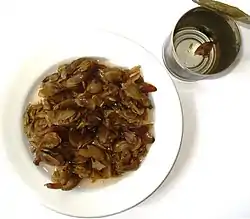Waterblommetjiebredie
Waterblommetjiebredie/ˌvɑːtərˌblɔmikiˈbrɪədi/ is a stew. The name comes from the Afrikaans language and literally means 'little water flowers stew'. It is made of meat, typically lamb, stewed together with the waterblommetjies (Aponogeton distachyos flowers)[1] which are found in the dams and marshes of the Western Cape of South Africa.[2] The buds of Aponogeton distachyos are usually ready to be picked in the southern midwinter months of July and August, leading to their use in winter stews such as waterblommetjiebredie.
 | |
| Type | Stew |
|---|---|
| Place of origin | South Africa |
| Region or state | Western Cape |
| Main ingredients | Meat (typically lamb), Aponogeton distachyos flowers |
The taste of the stew has been described as much like stewed green beans.[3] Waterblommetjiebredie is a local delicacy in South Africa.[1]
History
Waterblommerjiebredie was first prepared by the Khoikhoi people indigenous to South Africa.[4] They taught the early settlers of South Africa how to use waterblommetjie as food and medicine.[5]
Recipes
The typical main ingredients of waterblommetjiebredie:[6][7][8]
- lamb or mutton
- waterblommetjies
- Cape sorrel (surings in Afrikaans)
- onions
- potatoes
- salt and pepper
See also
Notes
- Pippa de Bruyn; Keith Bain (18 November 2011). Frommer's South Africa. John Wiley & Sons. p. 40. ISBN 978-1-118-17619-1.
- African FLowering Plants Database: Aponogeton distachyos
- Harlan Walker (1 January 1998). Fish: Food from the Waters. Oxford Symposium. p. 225. ISBN 978-0-907325-89-5.
- Ultimate Food Journeys: The World's Best Dishes and Where to Eat Them. DK Publishing. 3 October 2011. p. 166. ISBN 978-0-7566-9588-0.
- Edible & Medicinal Flowers. New Africa Books. 2000. p. 80. ISBN 978-0-86486-467-3.
- "Newsletter #26". Funky Munky. 8 June 2002. Retrieved 7 September 2010.
- Olivier, Michael (29 June 2009). "Waterblommetjie Bredie". Retrieved 7 September 2010.
- "Waterblommetjiebredie". Man in the Kitchen. Archived from the original on 13 January 2008.